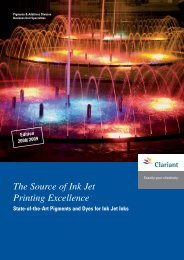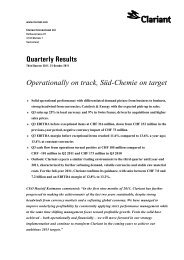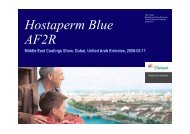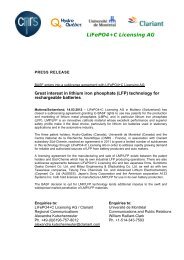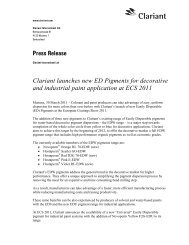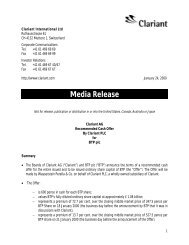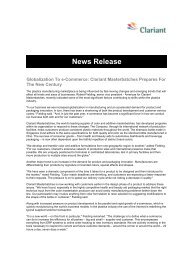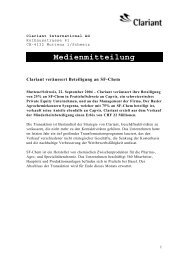DA 3303 E hostanox P-EPQ 09.07 RZ
DA 3303 E hostanox P-EPQ 09.07 RZ
DA 3303 E hostanox P-EPQ 09.07 RZ
You also want an ePaper? Increase the reach of your titles
YUMPU automatically turns print PDFs into web optimized ePapers that Google loves.
Pigments & Additives Division<br />
Plastic Business<br />
Hostanox ®* P-<strong>EPQ</strong> ®<br />
Clarifier Effect in Polypropylene<br />
Exactly your chemistry.
Hostanox ® * P-<strong>EPQ</strong> ®<br />
Introduction<br />
Hostanox ® * P-<strong>EPQ</strong> ® is a highly<br />
effective processing and color<br />
stabilizer for thermoplastic polymers.<br />
It is particularly recommended for<br />
use in polyolefins, especially if tough<br />
requirements, such as high temperature<br />
or demanding shear conditions,<br />
severely attack polymer melts during<br />
processing.<br />
One unique effect of Hostanox P-<strong>EPQ</strong><br />
is its contribution to improved transparency<br />
of polyolefins. This additional<br />
benefit of the processing stabilizer is<br />
clearly pronounced in polypropylene<br />
homo- and copolymers and in LLDPE.<br />
2<br />
> Clarifier Effect in Polypropylene<br />
The classic nucleating agents, e.g.<br />
benzoates, phosphates or sorbitol<br />
derivatives, are typically intended to<br />
influence the spherulite size distribution<br />
and the morphology of semicrystalline<br />
polymers. Characteristic<br />
effects on the physical properties<br />
are, for example:<br />
> Increased crystallization<br />
temperature<br />
> Increased rate of crystallization<br />
> Increased degree of crystallinity<br />
> Reduced average size of the<br />
spherulites<br />
> Increased contact and/or seethrough<br />
clarity<br />
> Improved surface gloss<br />
> Enhanced dimensional stability<br />
of molded parts<br />
> Improved mechanical properties,<br />
such as tensile strength or flexural<br />
modulus<br />
Hostanox P-<strong>EPQ</strong><br />
Hostanox P-<strong>EPQ</strong> complements many<br />
applications of nucleating agents<br />
and may even compensate certain<br />
draw-backs. Such combinations offer<br />
additional benefits:<br />
> Improved color retention during<br />
melt processing<br />
> Minimized yellowing of formulations<br />
containing sorbitol derivatives<br />
> Full compatibility with nucleating<br />
agents<br />
Some examples on the aspects<br />
mentioned above are illustrated in<br />
the following two chapters. All tests<br />
were performed in third generation<br />
polypropylene random copolymers.
Nucleating Properties of<br />
Hostanox P-<strong>EPQ</strong><br />
Figure 1 illustrates the clarifying effect<br />
of Hostanox ® * P-<strong>EPQ</strong> ® measured<br />
on injection molded polypropylene<br />
plaques. After the addition of 0.1%<br />
Hostanox P-<strong>EPQ</strong>, the haze is reduced<br />
by 10 - 15 % compared to the control<br />
sample, whereas P-2 and P-4 have<br />
significantly weaker effects. This<br />
clarity improvement remains nearly<br />
unchanged during multiple extrusion<br />
at 270 °C. Typical clarifiers like NA-1<br />
can even lose their performance under<br />
severe stress conditions (e.g. peak<br />
temperatures, prolonged heat exposure<br />
of the melt), eventually yielding<br />
only marginally improved haze values<br />
in the finished plastic articles.<br />
The improved transparency achieved<br />
just by addition of Hostanox P-<strong>EPQ</strong><br />
correlates with an increase of the<br />
tensile strength (TS) and the crystallization<br />
onset temperature (COT).<br />
As shown in Figure 2, Hostanox P-<strong>EPQ</strong><br />
can improve the tensile strength by<br />
approx. 10 % compared to the reference<br />
(BS only), whereas the competitive<br />
stabilizers have less effect on this<br />
property. The processing stabilizer<br />
Hostanox P-<strong>EPQ</strong> can act to a certain<br />
extent as a nucleating agent. It can<br />
improve the clarity of polypropylene<br />
and enhance its mechanical properties.<br />
Haze (%) after ...<br />
50<br />
40<br />
30<br />
20<br />
10<br />
0<br />
BS only P-<strong>EPQ</strong> P-2<br />
P-4<br />
BS + NA-1<br />
Procedure: Multiple Extrusion at 270 °C.<br />
Specimens: 1 mm Injection Molded Plaques.<br />
Figure 1: Haze of Polypropylene Plaques<br />
1st Extrusion 3rd Extrusion 5th Extrusion<br />
Additives: BS: 0.05 % AO-2 + 0.1 % CaSt;<br />
0.1 % Processing Stabilizer each;<br />
0.25 % Nucleating Agent NA-1.<br />
Tensile Strength<br />
(N/mm<br />
30<br />
150<br />
2 ) TS COT<br />
COT (°C)<br />
20<br />
10<br />
0<br />
BS only P-<strong>EPQ</strong> P-2<br />
P-4 BS + NA-1<br />
Procedure: Mechanical Testing and DSC<br />
Performed after one Extrusion Pass<br />
at 270 °C.<br />
Specimens: 1 mm Injection Molded Plaques.<br />
Additives: BS: 0.05 % AO-2 + 0.1 % CaSt;<br />
0.1 % Processing Stabilizer each;<br />
0.25 % Nucleating Agent NA-1.<br />
Figure 2: Crystallization Onset Temperature (COT) and Tensile Strength (TS) of Polypropylene Random Copolymer<br />
100<br />
50<br />
0<br />
3
Influence of NA-1 on the<br />
Stabilization of Polypropylene<br />
during Extrusion<br />
Data on the melt and color stability of<br />
polypropylene are shown in Figures 3<br />
and 4, illustrating the effect of the nucleating<br />
agent NA-1 on the performance<br />
of the stabilizers Hostanox ® *<br />
P-<strong>EPQ</strong> ® , P-2 and P-4 respectively. By<br />
using 0.1 % Hostanox P-<strong>EPQ</strong>, optimal<br />
melt stability is achieved for five repeated<br />
extrusions. Its effectiveness<br />
as melt stabilizer is almost maintained<br />
also in presence of NA-1.<br />
The corresponding results for the<br />
color stability shown in Figure 4<br />
support, furthermore, the preferred<br />
use of Hostanox P-<strong>EPQ</strong> also in<br />
nucleated polypropylene. It is evidently<br />
superior to the competitive<br />
phosphites P-2 and P-4.<br />
4<br />
MFR (g/10 Min.)<br />
at 230 °C, 5 kg<br />
20<br />
15<br />
10<br />
5<br />
0<br />
only BS+P-<strong>EPQ</strong> P-<strong>EPQ</strong> P-2<br />
P-4<br />
Procedure: Multiple Extrusion at 270 °C.<br />
Figure 3: Melt Stabilization of Polypropylene<br />
The distinct properties of nucleated<br />
polyolefins are significantly dependent<br />
on the chemical structure and the kind<br />
of nucleating agent applied. The typical<br />
heterogeneous nucleators, such as<br />
Hostanox 4030 or NA-3, are high<br />
melting, salt-like compounds which<br />
are primarily designed to improve<br />
crystallization kinetics and mechanical<br />
properties of a polymer. In contrast to<br />
this, dibenzylidene sorbitols like NA-1<br />
and NA-2 are preferably used as<br />
clarifiers, i.e. for reduction of haze.<br />
1 Pass 3 Passes 5 Passes<br />
Additives: BS: 0.05 % AO-2 + 0.1 % CaSt;<br />
0.1 % Processing Stabilizer each;<br />
0.25 % Nucleating Agent NA-1 each.<br />
Figure 5 shows the influence of<br />
processing stabilizers on the haze of<br />
polypropylene containing different<br />
nucleating agents.<br />
The formulations with NA-1 and NA-2<br />
in Figure 5 are examples for highly<br />
clarified polypropylene. In such cases,<br />
processing stabilizers contribute only<br />
marginally to further improvement of<br />
the optical properties. However, if<br />
heterogeneous nucleators are used<br />
(Hostanox 4030 and NA-3 in Figure 5),<br />
the generally higher haze values can<br />
be clearly reduced in combinations<br />
with Hostanox P-<strong>EPQ</strong>.
Yellowness Index<br />
(on Plaques)<br />
5<br />
4<br />
3<br />
2<br />
1<br />
0<br />
only BS+P-<strong>EPQ</strong> P-<strong>EPQ</strong> P-2<br />
P-4<br />
Procedure: Multiple Extrusion at 270 °C. Additives: BS: 0.05 % AO-2 + 0.1 % CaSt;<br />
0.1 % Processing Stabilizer each;<br />
0.25 % Nucleating Agent NA-1.<br />
Figure 4: Color Stabilization of Polypropylene<br />
Haze (%)<br />
60<br />
50<br />
40<br />
30<br />
20<br />
10<br />
0<br />
1 Pass 3 Passes 5 Passes<br />
only BS 0.1 % P-<strong>EPQ</strong> 0.1 % P-2 0.1 % P-4<br />
NA-1 NA-2 Hostanox ® *-4030 ®<br />
Procedure: Haze measured after one<br />
Extrusion Passage.<br />
Specimens: 1 mm Injection Molded Plaques.<br />
Figure 5: Effect of Processing Stabilizers in Nucleated Polypropylene<br />
NA-3<br />
Additives: BS: 0.05 % AO-2 + 0.1 % CaSt;<br />
0.25 % Nucleating Agent each.<br />
5
Conclusion<br />
Hostanox ® * P-<strong>EPQ</strong> ® has to be considered<br />
as the additive of choice in<br />
applications of polypropylene where<br />
superior stabilization is required.<br />
Particularly in clarified or nucleated<br />
polypropylene, the use of Hostanox<br />
P-<strong>EPQ</strong> safeguards excellent melt and<br />
color stability during processing of<br />
the resin.<br />
6<br />
Experimental<br />
Third-generation polypropylene random<br />
copolymer was melt compounded<br />
with the respective additive formulations.<br />
The following base stabilization<br />
(BS) was used: 0.1 % calcium<br />
stearate plus 0.05 % AO-2. Processing<br />
stabilizers (PS) were applied at 0.1 %<br />
and nucleating agents (NA) at a level<br />
of 0.25 %.<br />
Preparation of the Samples<br />
Additives were dry blended with the<br />
polymer and pre-extruded at 210 °C.<br />
Multiple extrusions were carried out<br />
on a single screw laboratory extruder<br />
(compression ratio 1:3, L:D = 25, 50<br />
rpm). The strand was chilled in water<br />
and pelletized. These samples were<br />
used for MFR characterization, reprocessing<br />
and for injection molding<br />
into 100 x 100 x 1 mm3 plaques on<br />
an Arburg Allrounder 221-75-350 at<br />
245 °C.
Mode of Characterization<br />
Melt Flow Ratio (MFR) according<br />
to ASTM D-1238 (equivalent to ISO<br />
1133) using pelletized polymer.<br />
Yellowness Index (YI) according<br />
to ASTM D-1925 measuring light<br />
reflection on 1 mm plaques.<br />
Haze Value according to ASTM D-1003<br />
measuring light scattering through<br />
1 mm plaques.<br />
Tensile Strength (TS) according to DIN<br />
53455 applying a crosshead speed of<br />
10 cm/min. The specimens for tensile<br />
testing were punched out of 1 mm<br />
injection moulded plaques.<br />
Crystallization Onset Temperature<br />
(COT) measured on Mettler DSG.<br />
Temperature (COT) 20 thermoanalyzer.<br />
Starting temperature 200 °C, cooling<br />
rate -10 °C/min.<br />
Key to Abbreviations<br />
AO-2:<br />
Tetrakis-[methylene-3-(3',5'di-tert-butyl-4'-hydroxy-phenyl)propionate]-methane<br />
P-2:<br />
Tris(2,4-di-tert-butylphenyl)<br />
phosphite<br />
P-4:<br />
Tris(nonylphenyl) phosphite<br />
(TNPP)<br />
Heterogeneous Nucleators<br />
Hostanox ® * 4030:<br />
Aluminium-monohydroxy-di-<br />
(4-tert-butyl-benzoate)<br />
NA-3:<br />
Sodium-di-(4-tert-butyl-phenyl)<br />
phosphate<br />
Homogeneous Nucleators<br />
NA-1:<br />
1,3:2,4 Di-benzylidene sorbitol (DBS)<br />
NA-2:<br />
1,3:2,4 Di-(4-methyl-benzylidene)<br />
sorbitol<br />
7
Please note<br />
This information is based on our present state of knowledge and is intended to provide<br />
general notes on our products and their uses. It should not therefore be construed<br />
as guaranteeing specific properties of the products described or their suitability for<br />
a particular application. Any existing industrial property rights must be observed.<br />
The quality of our products is guaranteed under our General Conditions of Sale.<br />
® = Trademark of Clariant registered in numerous countries<br />
®* = Trademark registered in numerous countries and licensed to Clariant<br />
Edition: September 2007<br />
www.pa.clariant.com<br />
Clariant International Ltd.<br />
Pigments & Additives Division<br />
Marketing Plastic Business<br />
Rothausstrasse 61<br />
4132 Muttenz<br />
Switzerland<br />
Phone: +41- 61- 469-7466<br />
Fax: +41- 61- 469-7540<br />
Clariant Produkte (Deutschland) GmbH<br />
Pigments & Additives Division<br />
Marketing Plastic Business<br />
Ludwig-Hermann-Straße 100<br />
86368 Gersthofen<br />
Germany<br />
Phone: +49 -821-479-2693<br />
Fax: +49 -821-479-2968<br />
Clariant Production (France)<br />
Pigments & Additives Division<br />
Marketing Plastic Business<br />
Boîte Postale 149<br />
68331 Huningue Cedex<br />
France<br />
Phone: +33 -389-89-6000<br />
Fax: +33 -389-89-6197<br />
Exactly your chemistry.<br />
<strong>DA</strong> <strong>3303</strong> E_09/07





